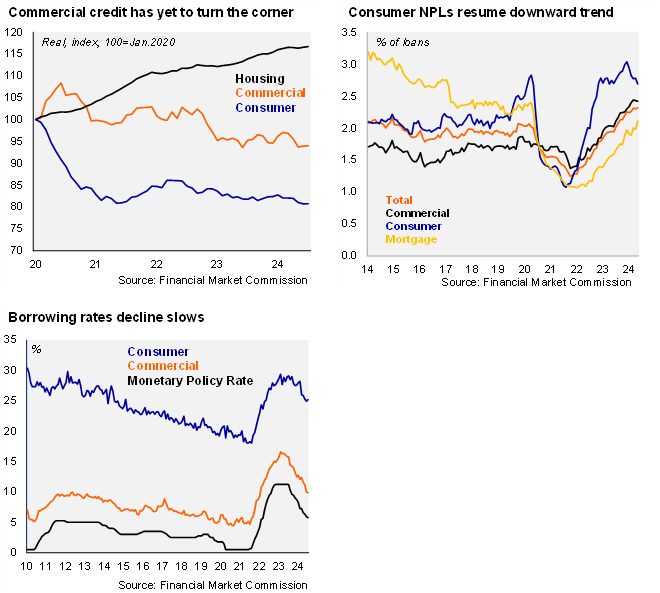According to the Financial Market Commission, the banking system’s stock of outstanding real loans in Chile fell slightly in July by 0.56% YoY, falling back to negative territory after being flat in annual terms in June (0.0% in June, -3.92% in July 2023). Outstanding real commercial loans in Chile slipped in July falling by 2.99% YoY, (-1.69% in June, -6.68% in July 2023), declining on an annual basis since May 2022. Even though the stock of outstanding real commercial loans fell again, on a flow basis they rose by 25.5% in the quarter ending in July, the fastest annual pace since February 2023, likely reflecting base effects. Outstanding consumer loans in Chile continue to contract but at a smaller pace, falling by 0.95% YoY in July (-1.37% in June, -3.08% in July 2023), albeit contracting on an annual basis since January 2023. Real outstanding mortgage loans in Chile rose by 2.27% (2.37% in June, 1.84% in July 2023).
Non-performing loans (defined as delinquencies of more than 90 days) were essentially flat at the margin at 2.32% (2.30% in June, 1.95% in July 2023), in line with our expectation for a stabilization at the highest levels since 2014. As such, the banking system’s NPLs remain well above the March 2014 – March 2020 average of 1.95%. By loan type, consumer NPLs fell at the margin to 2.69% in July (2.78% in June, 2.75% in July 2023), resuming a gradual downward trend that had been interrupted with a marginal increase in June; consumer NPLs peaked in the cycle at 3.04% in February, with the improvement likely linked to lower borrowing costs and improvements in the real wage bill. Mortgage NPLs rose at the margin to 2.11% in July (1.98% in June, 1.57% in July 2023), yet still well below the pre-covid 2.4% level. Commercial NPLs were flat at 2.42% in July (2.43% in June, 2.03% in July 2023), close to the highest level at least since 2014, trending up from the low of 1.37% in December 2021.
Commercial borrowing rates fell again in July, yet pace of decline should slow. Interest rates in nominal terms on consumer loans averaged 25.18% in July, up slightly from 24.91% in June, yet below the 29.1% of July 2023; the spread with respect to the monetary policy rate reached 19.43pp, above the two-year average (18.1%). In contrast, interest rates in nominal terms on commercial loans fell in July, averaging 9.88%, down from 9.97% in June, and well below the 15.75% of July 2023; the spread with respect to the monetary policy rate fell to 4.13%, below the two-year average (4.5%). The decline in interest rates on commercial and consumer loans is likely to slow for consumer loans and pause for commercial loans, considering the BCCh’s guidance on rates and historical spreads. Inflation-linked rates on mortgages rose sequentially for the fourth consecutive month to an average of 5.03% in July, up slightly from 5.00% in June, and substantially above the 4.24% of July 2023.
Our take: Weak credit dynamics through July appear consistent with a slow recovery of investment next year. As we had anticipated, the decline of borrowing rates for consumer and commercial loans was interrupted in July, in line with the expectation of smaller adjustments to the monetary policy rate. The renewed decline in consumer NPLs is in line with our view, yet the persistent rise and recent jump in mortgage NPLs should be monitored which may be linked to mortgages that shifted from fixed to variable rates. The Financial Market Commission will release data for August on September 30.

